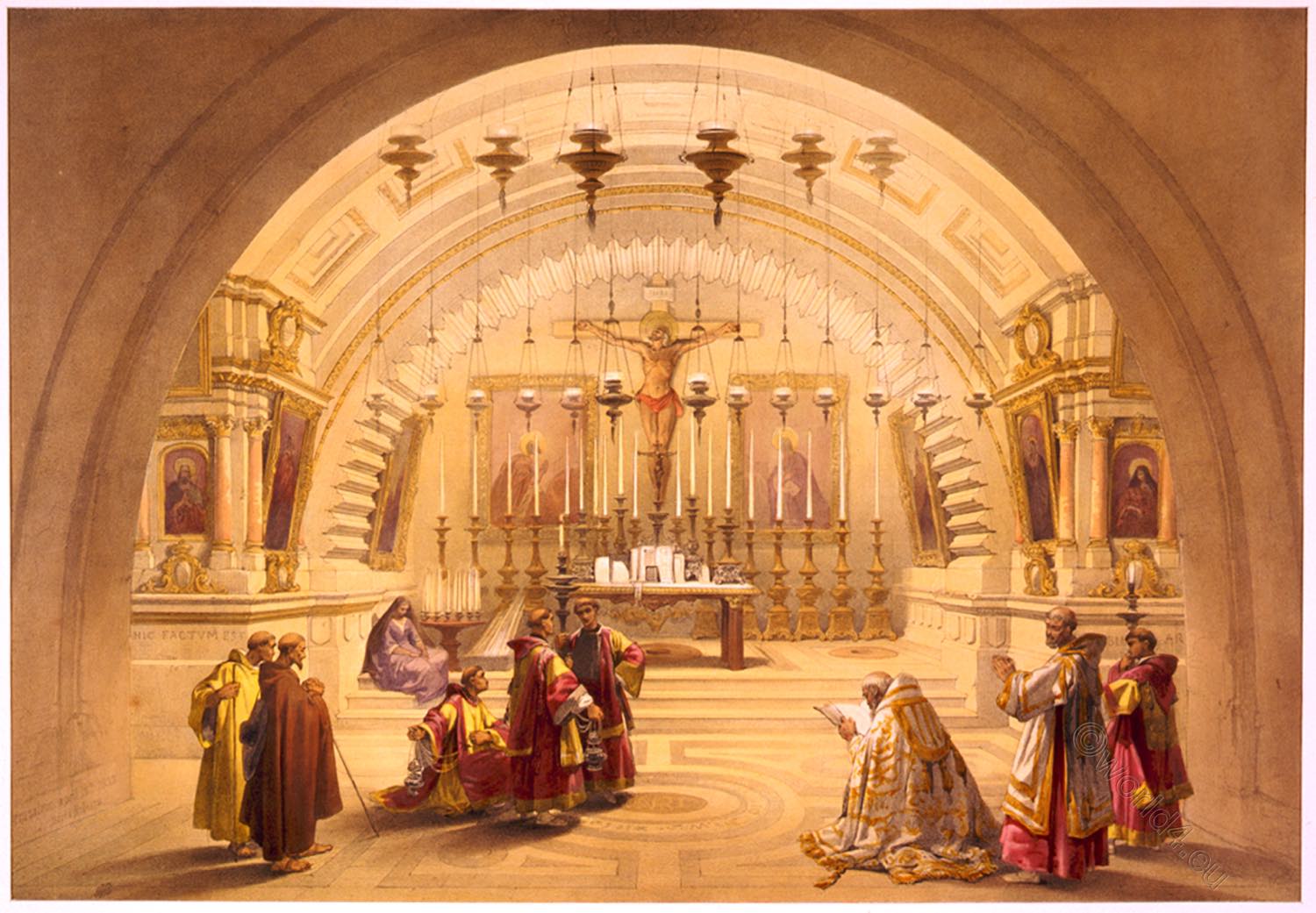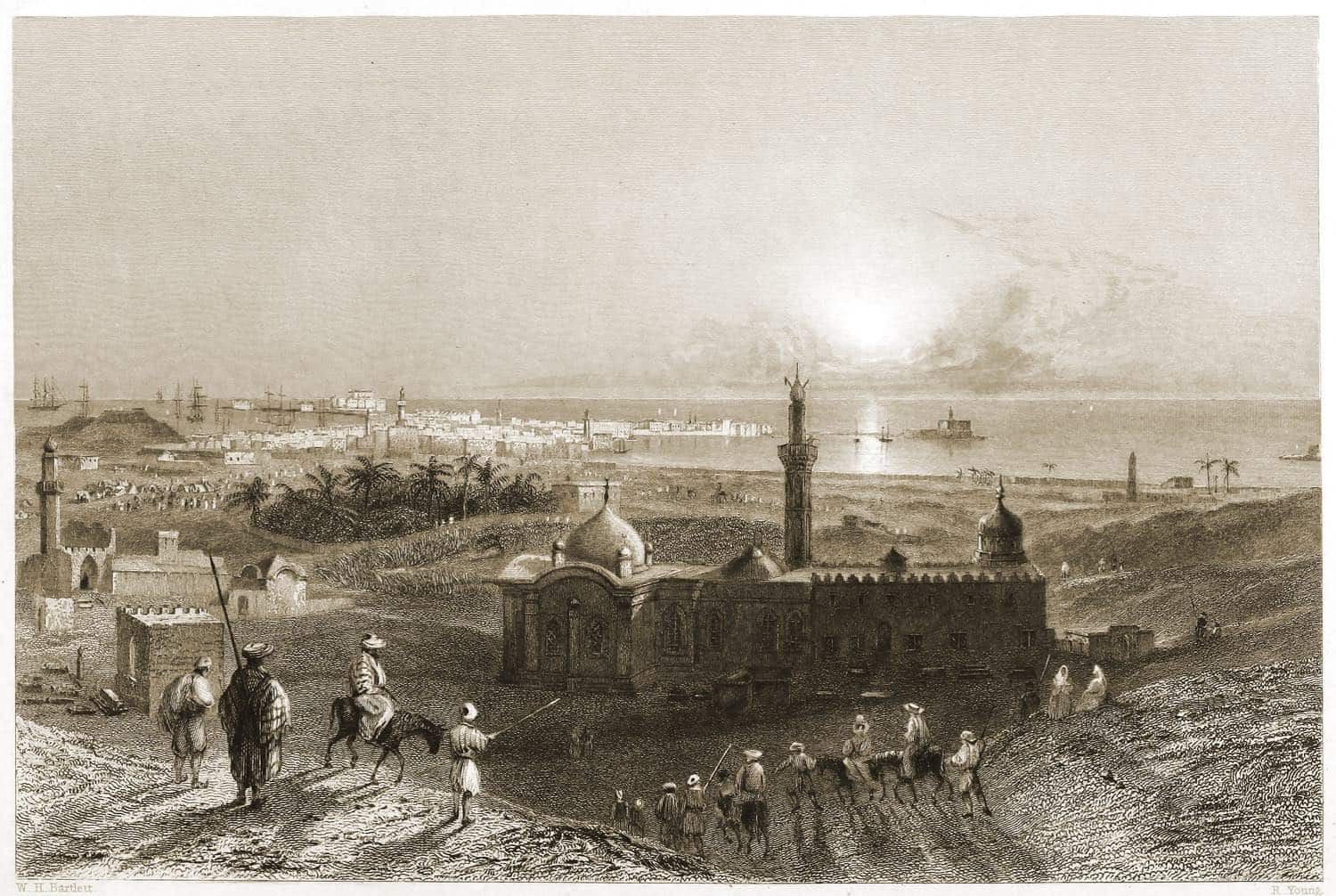
THE CHURCH OF THE PURIFICATION.
by David Roberts
An inquiry has been long on foot among the intelligent investigators of the Holy Land, for the site of the great Church built by Justinian, in honour of the Virgin Mary, in the sixth century. Procopius, in his description of the imperial works,1) states it to have been erected on the loftiest hill of the city; adding, that as there was not space enough for its intended magnitude, the architect was compelled to raise a wall with arched vaults from the valley to support the south-east part of the edifice. The only fabric whose site corresponds with this description is the Mosque El-Aksa, at the southern extremity of the inclosure of the Harem-esh-Sherif. It stands adjacent to the southern wall, where the latter is about one hundred feet above the foundation of the parallel city wall. The mosque is 280 feet in length from north to south by 190 broad. It is universally regarded by the Oriental and Western Christians as an ancient Christian Church, once dedicated to the Virgin, and the latter give it the name of the Church of the Purification or Presentation.2) The interior retains exactly the appearance of an ancient Basilica.3)
In researches like these, the reader must be warned of the extreme difficulty of verifying points of topography much more important than the sites of imperial labors. Until the beginning of the fourth century Jerusalem was in Roman hands, deprived of all rights but those which cannot be refused even to the slave, and almost forgotten by the world. The establishment of Christianity on the imperial throne once more turned the general eye to Jerusalem, yet less as the seat of Jewish grandeur than as the memorial of Christian sacrifice. Invention became busy, and perhaps unscrupulous.
Whatever the mother of the Emperor sought for, she was sure to find. Where the site was unknown to authentic record, tradition was ready, or where even tradition failed, all difficulty vanished before a dream. Thus Helena ascertained all the chief localities of the life of our Lord in Jerusalem. During the three following centuries Jerusalem became a place of pilgrimage to the pious, the curious, and the superstitious.
The pilgrims adopted the legends of the past, or made legends of their own; until every spot of the sacred region was partitioned among rival fables. But this visionary age received a sudden and formidable check; the Saracen came, overspreading the land like a flood, and the pilgrim and the fable perished together. The Crusades were a bold and brilliant effort to restore the fallen honors of Jerusalem but, while the Saracen scimitar was still glittering from the Nile to Lebanon, the knights were too amply employed in guarding their feeble sovereignty, to revive controversies, which probably their martial habits taught them to disdain.
On the revival of letters in Europe, Jerusalem became once more that object of interest, which it has continued to the present day. But the eager acquiescence with which the first travelers listened to the authority of the Conventuals, was suddenly changed into almost total doubt ; and a species of calm skepticism as to every locality became the tone of the European traveller.4) This, too, has had its period, and a more rational spirit has succeeded. But Jerusalem is already assuming in the European eye a higher rank than belongs to historic recollections. For to what other spot of earth was language like this ever spoken?
“It shall come to pass in the last days, that the mountain of the Lord’s house shall be established in the top of the mountains.
“And many people shall go and say, Come ye, and let us go up to the mountain of the Lord, to the house of the God of Jacob … for out of Sion shall go forth the law, and the word of the Lord from Jerusalem.
“O house of Jacob, come ye, and let us walk in the light of the Lord.” 5)
1) Procop. de AEdificiis, Justin, v. 6. 2) The title of the Purification is rejected by Quaresmius. 3) Bononi, quoted in Bib. Researches, vol. i. p. 439. 4) Rauwolf, Korte, and Cotovicus, were among the chief doubters until the visit of Clarke, who; doubts everything. Robinson, who has been adopted as our chief authority in these descriptions, evidently deserves respect for his judgment, diligence, and learning. 5) Isaiah, ii. 2, 3, 5.
Source: The Holy Land, Syria, Idumea, Arabia, Egypt, & Nubia, by David Roberts, George Croly, William Brockedon. London: Lithographed, printed and published by Day & Son, lithographers to the Queen. Cate Street, Lincoln’s Inn Fields, 1855.
Archaeological evidence, however, indicates that this famous church was actually in another quarter of the city and not on the Temple Mount. The Church of the Purification is, in fact, not represented in this westward view of the Jerusalem landscape. What Roberts does depict in Church of the Purification, however, in addition to the Al-Aqsa Mosque, is the famous Western (or Wailing) Wall (one of the most sacred sites in Judaism) and the renowned gold-domed Islamic shrine, the Dome of the Rock. Through this scene, Roberts offers a distant view of Temple Mount, one of the most important religious sites in Jerusalem—and one held sacred by Christianity and Judaism as well as Islam. Source: Dahesh Museum of Art
Continuing
Discover more from World4 Costume Culture History
Subscribe to get the latest posts sent to your email.






